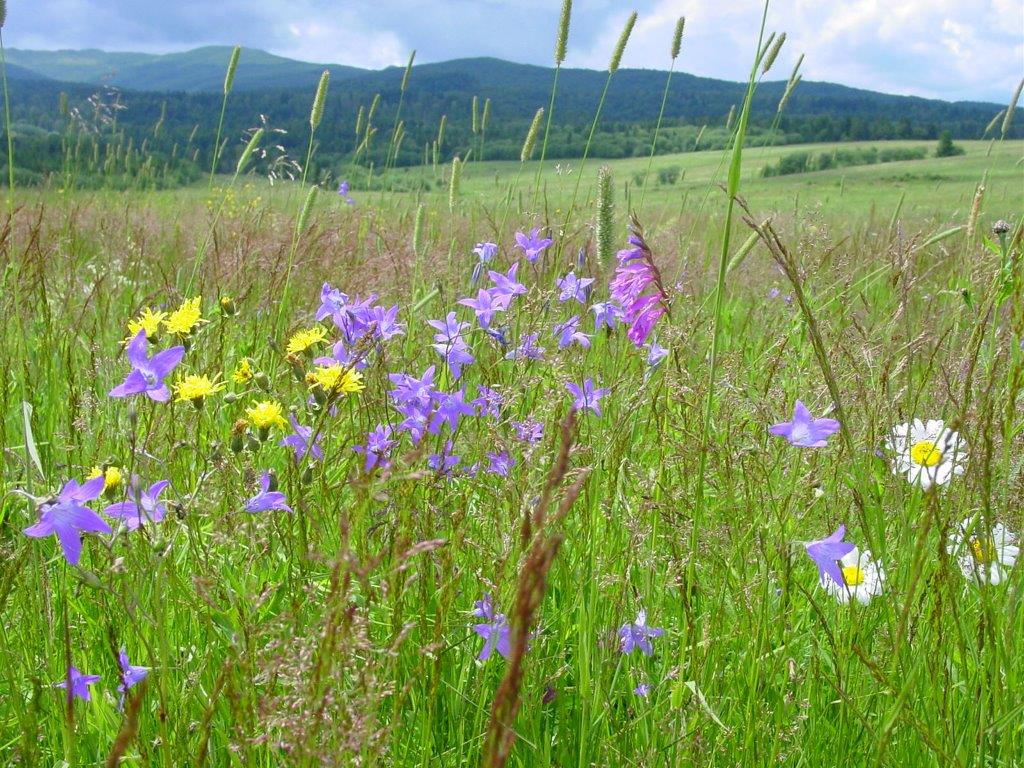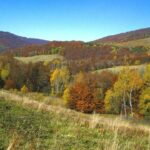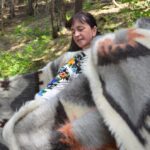The currently functioning system of extensive grazing in which animals have a relative freedom of movement around vast areas, pastures usually encompass fresh grasslands. In light of the short period of time during which animals remain in a single area, the grassland turf rather weakly and selectively stripped and its trampling occurs in a limited degree. In such conditions, the grassland plant communities regenerate seamlessly, and the use of the area may occur alternately. We thus distinguish the initial vegetation period that covers an intense growth of trees (until their swath) and later duration of pastoral use, related to adjusting the re-growing, good-quality fresh grassland turf. Before the war, density of farming estates did not allow for such a luxury – fruits remained for a longer periods of time on a single area, growing out the turf to the bare ground, whilst at the same time contributing to changes in the structure and content of soil. These changes were caused by the erosion of surface layers on the mountain slopes or by significant eutrophication in the valleys and clearings with weaker inclinations.
Nowadays, grazing in an intense system is organized quite seldom, nevertheless, its traces are visible even today. Permanent burden has been impacting the soils, the species composition of meadows, modifications of vegetation community placements (i.e. secondary occurrence of munk’s rhubarb flaps in “the land of valleys”), as well as in the form of synanthropic plant flaps. Among the last ones communities closely linked to long-term grazing prevail. The largest area is occupied by twin turfs, slightly smaller humid sieve pastures and fertile rye-cynosurus grasses pastures, whilst in case of trophic-poorer soils – pastures with occurrence of red fescue. Let us take a closer look at those plant communities that have remained in our landscape as the most remarkable symbol of the former and current grazing.
A. Twin grasslands (grassland Nardion)
Multi-species twin grasslands of Nardion strictae type constitute an exceptionally precious natural habitat, of significance from the point of view of phytocentric and species diversity. It is also worth to not that it is overally a sensitive and non-stable succession link for which intense and permanent grazing is the condition of existence. The widespread disappearance of the pasture form of managing grasslands has led to substantial reduction of twin grassland areas, whilst their complete disappearance has been detected in some areas. The most radical disappearance of this type of habitants within the past 70 years has been observed in the alpine level and high-located alpine pastures and concerned eastern Carpathian Alpine twin grasslands (Hypochoeridi-Nardetum).
 Twin grasslands scattered on subalpine forest glades (Berehy)
Twin grasslands scattered on subalpine forest glades (Berehy)
B. Fertile rye-cynosurus grasses (Lolio-Cynosuretum)
Pastures with large share of low grass species such as rye grass and cynosurus grass are characterized by high resistance to stripping and trampling and take the form of a relatively low and dense structure. They occur on intensively grazed areas countrywide as the basic flora in relatively fertile places and on relatively humid soils (non-waterlogged). In toxonomic terms a rye-cynosurus grassland belongs to the class of Molinio-Arrhenatheretea and Arrhenatheretalia order – it thus is very related to fresh meadows with which it forms a rich zone of transitional and mosaic phytocenosis. In the territory of the Bieszczady National Park they may be encountered today only on some small and dispersed positions in places related to the presence of horses and sheep. Whilst, in the BdPN lagging and in the Sanockie-Turczańskie Mountains these areas are rather frequently met – especially where until recently an intense grazing was conducted.
C. Festuca-cynosurus pastures (Festuco-Cynosuretum)
This community consists of vicariance phytocenoses (substitutive) towards the formerly described Lolio-Cynosuretum which is to a larger degree related to lower locations. Festuco-Cynosuretum grassland is a typical mountain pasture, frequently encountered in subalpine forest valleys, characterized, apart from the presence of cynosurus, by Cynosurus cristatus – significant participation of red fescue Festuca rubra in a tufty variety. In the phytosociological system both communities belong to the same units – order Arrhenatherion (fresh meadows) and grassland Cenosurion (cynosurus pastures). The nature of the habitat and its relation to the manner of management of the are also similar.
 Festuca-cynosurus pastures maintained due to Scottish cattle grazing
Festuca-cynosurus pastures maintained due to Scottish cattle grazing
(one of the new breeds in Bieszczady), Chmiel on the San river
D. Wet sieve pastures (Epilobio-Juncetum effusi)
Sieve pasture belongs to the group of popular communities occurring in the area of wet meadow complexes that were formerly subjected to grazing or which are still used for this purpose. This complex is formed mainly by communities that came into being on wet soils with weakly permeable mineral surface. Only the upper layers of the profile tend to have slight humus properties, whilst in lower parts gleyed surfaces prevail (clay soil). The water thus prevails for a substantial part of the growing season just below the soil surface.
E. Grazed fresh meadows from order Arrhenatheretalia
Typical pastoral communities create broad transitional zones, showing affinity to various meadow floras. These frequently constitute lobes of tufted hair-grass (in case of fertilisation or colonial bent (as a result of its depletion through an intense grazing without proper fertilization). In such situations we may observer a smooth passage to wet meadows or to fresh meadows. On the slopes above the valley bottom the most frequently met component of such pastures is the mountain agrostis meadow (Campanulo serratae-Agrostietum capillaris), submontane darnel meadow (Arrhenatheretum elatioris) and wet hair-grass meadow (Stellario-Deschampsietum caespitosae). In strongly fertilized areas we may observe a significant portion of papilionaceous and economically valuable grass types – timothy Phleum pratense, cocksfoot Dactylis glomerata and fescue meadow Festuca pratensis. On the other hand, shallow and poor quality soils are usually overgrown with red fescue Festuca rubra. On fertile and humid soils, usually in the very bottom of a valley, pastures turn into fox-tail’s meadows.
Grazing of sheep on timothy-grass meadows (Berehy, Bieszczady National Park)
Text and photographs: dr Adam Szary


















